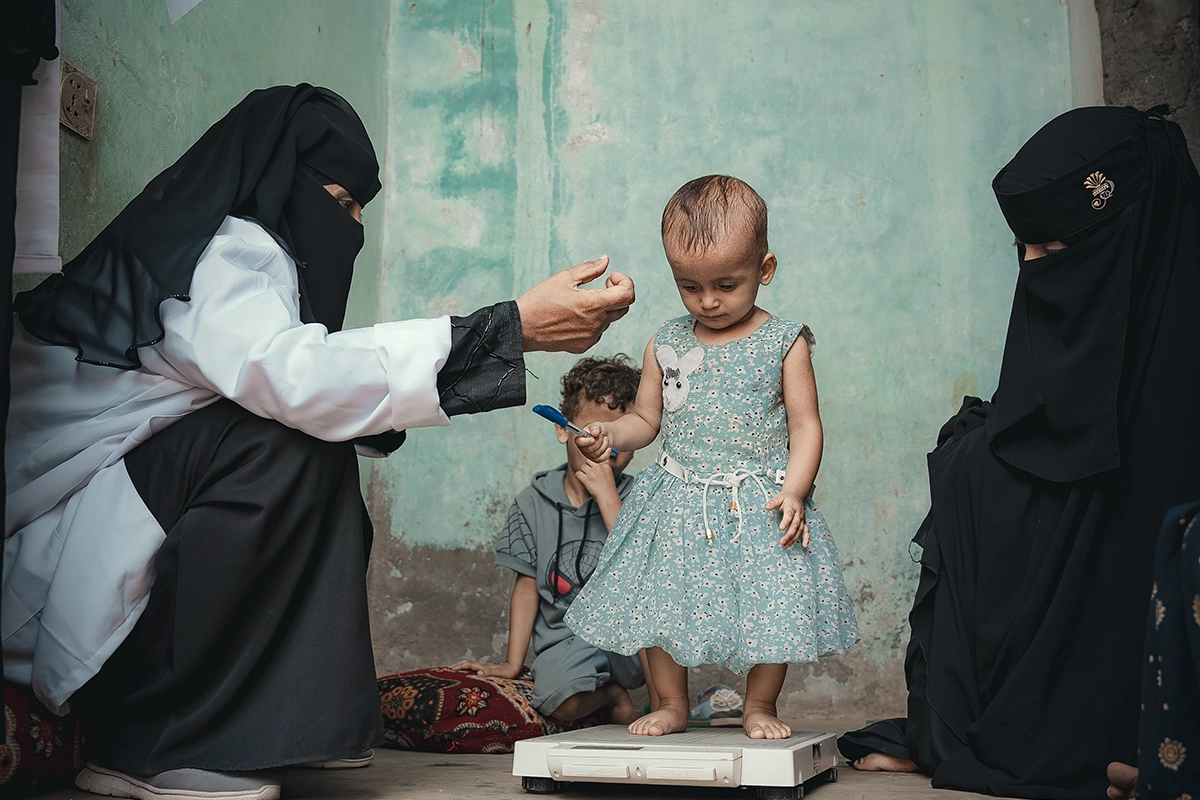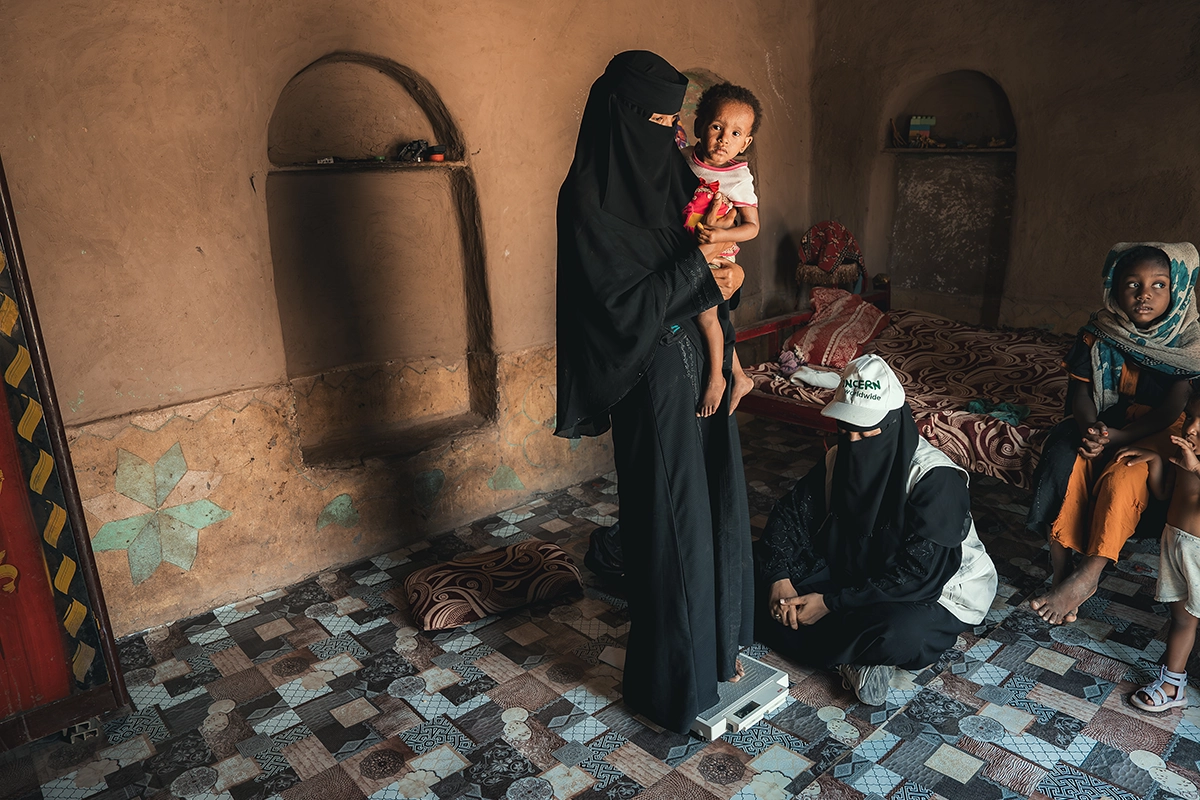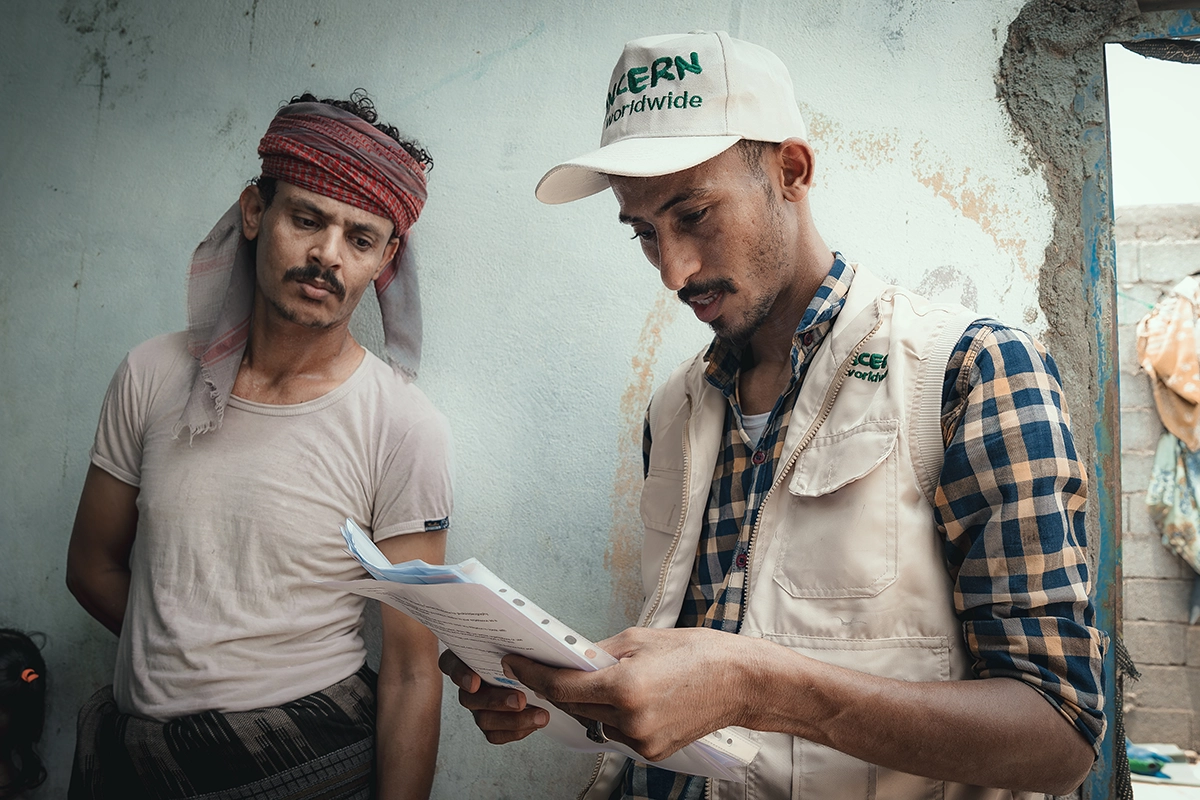News
The crisis in Yemen, explained
Learn more about what's going on in Yemen, ten years into its civil war — and why Concern is now working there.
Read MoreAt 16 months, Rima* is one of the youngest members of Yemen’s overwhelmingly young population (about 40% of residents are under the age of 15), with big brown eyes, a small patch of hair, and a shy smile that grows wider when playing with the other children in her neighborhood.
However, during a routine home visit from a Concern, Nabilah, a Community Health Volunteer (CHV), saw something else: “I saw that Rima is weak,” Nabilah recalls. “Her mother told me she was not eating well, often sick, and not sleeping well.” Nabilah performed a nutrition screening on the small girl. She found that Rima weighed just 7.1 kilograms (about 15.6 pounds) and that her mid-upper-arm circumference (MUAC) was just 12.3 centimeters (a little under five inches).
Rima’s weight relative to her MUAC measurements put her in the range for severe acute malnutrition, which seemed to be confirmed by the other symptoms described by Rima’s mother, Sameera*.

Nabilah told Sameera to bring her daughter to a health facility supported by Concern in their village of Alshaqa’a, part of the rural district of Tuban in Yemen’s Lahij Governorate. There, staff gave Rima a fuller examination and admitted her to the clinic’s outpatient therapeutic program in March of this year. She received a course of ready-to-use therapeutic food; her mother received resources (including a hygiene kit, soap, and a jerry can) to ensure proper hygiene practices and avoid health complications due to the current cholera outbreak in Yemen.
By April, Rima was up to 9.2 kg (over 20 pounds) and her MUAC had gained more than half a centimeter. Nabilah still visits her mother once a week for checkups and to share breastfeeding and hygiene resources. “Now, my child, husband, and I can sleep well,” says Sameera. “My child is getting healthy. No more crying all the time.” Still, she’s concerned for the future. “We don’t have any source of income. Rima’s father is struggling to get daily work. The prices of food items are going up and we cannot afford them,” she adds. “At least we are getting free health services, thanks to Concern.”
What they really need, Sameera says, is an opportunity to get out of poverty and rebuild their lives with a steady source of income. Without this, it’s not clear what Rima’s future will hold.
Rima’s and Sameera’s are not unique stories in Yemen, where nearly a decade of conflict — combined with political instability, economic issues, and the effects of climate change — have left it the poorest country in the Middle East.
In 2024, it is also the second-hungriest country in the world, based on this year’s Global Hunger Index. Yemen has the second-highest child stunting rate (second only to Burundi), the third-highest child wasting rate, and the fifth-highest undernourishment rate for children and adults.
Here’s what else you need to know about hunger in Yemen.

Yemen is among the countries most affected by climate change (and with very little resources to fight it) which, combined with years conflict and economic fallout, has left 50% of its population facing food shortages and nutritional deficiencies.
One of the biggest issues is that, even prior to the beginning of the war, Yemen relied on imports for 70% of its food needs. The country’s main staple, wheat, was 90% imported; other staples like rice, tea, and sugar were 100% imported. When conflict first broke out, Yemen’s main seaport, Hodeida, was met with restricted access, blocking trade access. Commercial importers also weren’t able to get the letters of credit they needed to buy staples.
As Sameera mentions, the economic effects of the war have also made it difficult to afford what food is available. Earlier this year, the Integrated Food Security Phase Classification (IPC), which tracks food security and famine conditions around the world, reported that, on average, food prices were up by 45%. Given that 80% of the country lives below the poverty line, this was a staggering (and for many families untenable) price increase.
The climate crisis also plays a big role in this setting, with its impacts rendered more catastrophic for families hit hard by the war. Roughly 70% of Yemeni families live in rural areas and rely on agriculture both for their food and their livelihoods. However, the country is vulnerable to droughts and water scarcity. Given these challenges, the UN estimates that harvests will decrease by 40% in 2024.

In addition to droughts (and the effects of this summer’s record-high temperatures), several governorates in Yemen were hit in August by heavy rainfalls and flash floods, which destroyed homes, farms, and infrastructure, while also eroding what little resilience many Yemenis have against these emergencies.
Further complicating matters is cholera. Over the last few years, Yemen has been one of the epicenters of the global cholera outbreak. A current wave began earlier this year, in March, with nearly 30,000 cases reported in just over a month. The heavy rains helped this to spread, with the Ministry of Public Health and Population reporting a cumulative total of over 186,000 suspected cases of cholera in the country at the beginning of September.
Children of Rima's age are more vulnerable to diseases like cholera as their bodies are still developing (especially their immune systems). Malnutrition weakens these systems, making them more susceptible to communicable illnesses and less able to fight them. This is why our nutrition team worked with Sameera on both treating her daughter’s malnutrition and preventing the spread of cholera within the family.
Amid deepening crisis, hunger rates in Yemen have gone up in 2024. The IPC estimates that, by the end of this year, nearly 610,000 children will be acutely malnourished (with over 118,500 expected to suffer severe acute malnutrition), a 34% increase compared to 2023 levels.
Earlier this month, Joyce Msuya, the UN’s Acting Under-Secretary-General for Humanitarian Affairs and Emergency Relief Coordinator, told the General Assembly: “In August, the number of people who do not have enough food to eat soared to unprecedented levels.” Msuya added that food deprivation levels have doubled in the last year in some areas.
Much of this comes down to a lack of access for humanitarian aid deliveries and underfunding. The UN’s 2024 humanitarian appeal for Yemen is currently 41% funded, meaning that we’re more than three-quarters of the way through the year but have received less than half the funding needed to meet basic needs in the country. In addressing the General Assembly, Msuya estimates that without a much-needed $870 million in available funding, an estimated 9 million people across Yemen will not receive their emergency food aid through the end of the year.

The immediate action that we need for Yemen is, as Msuya puts it, funding. The IPC reports that, in the first seven months of 2024, the World Food Program was only able to provide two cycles of general food assistance in the country, making this “the worst funding crisis for the food security and agriculture cluster since 2015.” General food assistance rations are currently just 17% of the recommended daily intake.
In addition to giving humanitarian funding for the needed response, humanitarian organizations also need to be able to access the most-affected areas of Yemen. While a UN-brokered truce in 2022 has led to continued stability in some parts of the country, other regions face ongoing violence that is preventing aid from getting where it’s needed most.

As Sameera told Concern, we also need to focus on longer-term solutions to the crisis, particularly with regards to livelihoods and economic security for families who have been affected by the protracted conflict. Restoring livelihoods will help promote local economic recovery and food production, and will also include a focus on helping the majority of Yemeni farmers to develop more climate-smart techniques to protect their farms against the ongoing effects of climate change.
In the end, however, ending hunger in Yemen will not be possible without also ending the crisis and conflict within the country. Hunger is a political issue as much as it is a humanitarian one. Nearly a decade of violence and suffering has shown us how much these two elements are connected, and how many lives are at stake.
Concern launched a formal program in Yemen in early 2024 designed to meet the ongoing urgent humanitarian needs. Our key areas of focus are Health & Nutrition and Water, Sanitation, and Hygiene (WASH).
In partnership with Medair, we’re delivering health services to five healthcare facilities in Lahij Governorate, including implementing community-level activities and supporting community volunteers. We’re also supporting a healthcare facility in Tuban District, which had previously been nonfunctional due to a lack of staff and supplies. So far, we have facilitated access to healthcare for over 10,400 people — more than half of whom are women and children.
Water and sanitation needs are among the highest in IDP camps, and we’ve responded to these needs by supporting WASH services in two camps in Aden Governorate, rehabilitating water wells and building latrines to help prevent the spread of waterborne diseases. Our focus also includes working with local water departments at both the governorate and district levels to support the rehabilitation of water networks and sanitation services in crowded urban settings, for both IDP and host communities.